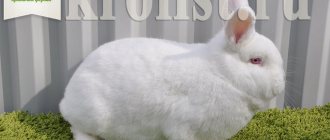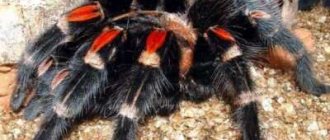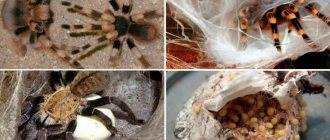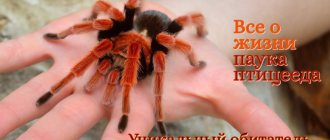Spiders 08/07/20203697 views
Grammostola rosea is perhaps one of the most popular spiders. This is due to its unusual coloring and rather calm disposition. There are two color variations of this spider. The classic color, from which the name comes, and red, completely different from the classic one.
The first is a bright pink carapace and off-white pubescence. According to the second, it is not clear why the spider is called pink. And in fact, it is brighter and stands out strongly among the colors of other spiders, and even the classic morph of this species, and therefore is more popular among breeders.
Features of the appearance of the pink tarantula
This is a hairy and quite beautiful spider. Mature males have long legs, while females are stockier. Males are smaller than females.
The average body length of a tropical tarantula is 5-6 centimeters, and the paw span is 16-18 centimeters. All tarantulas have more than three phalanges on their paws.
This spider can be recognized by the pink-red tips of its legs, from which it gets its name. The color of young individuals is blue with a metallic tint, and there are black stripes on the body. And adult spiders are blue-green or purple, and the abdomen is purple-orange. The color of adult males is darker than that of females.
Nutrition
The Chilean predator eats mainly insects that live on the surface of the earth. The pink tarantula spider can wait for prey for a long time, sitting at the entrance to its burrow. He usually hunts cockroaches and crickets, and on good days his food can be scorpions and even small mammals. The spider captures the victim with its powerful pedipalps and subdues it by injecting a small dose of poison into the bite site. Venom glands are excreted through a channel located in the chelicerae. Sometimes a predator does not consider it necessary to use poison on its prey, then it simply destroys the prey with the force of its jaws.
Lifestyle of tropical tarantulas
These are tree spiders that live in tropical forests. They hide high in the trees, in leaves rolled into a tube.
Antillean pink-footed tarantula (lat. Avicularia versicolor).
Juveniles feed on small crickets, live fruit flies and other small insects. And adult pink tarantulas attack flies, cockroaches, crickets, ants, moths and other large insects; geckos, anoles and mice also become their prey.
The character of these large spiders is quite calm; if the avicularia is frightened, it runs away as fast as it can. During the escape, the spider shoots excrement at the offender. If a young spider is in danger, it immediately jumps down. Tropical tarantulas are very fast and agile.
Over the years, the color of young spiders changes, and after 8-9 moults they look more like adults.
Puberty in pink tarantulas occurs at 1-1.5 years of age. After mating, the female sometimes eats the male. The female builds a strong web, in which she sits most of the time. She comes out to feed at dusk. During pregnancy, the female's appetite increases. A clutch may contain 50-200 eggs. The eggs develop over 6-8 weeks. The lifespan of pink tarantulas ranges from 4 to 10 years.
Reproduction
If you decide to breed Grammostola rosea, then get ready for the fact that you will have to create seasonal fluctuations, just like in its homeland. After successful mating, the temperature should be lowered by 4 degrees, and after a while raised, which will create the illusion of wintering. After mating for about 3 months, the female prepares to weave a cocoon, then the larvae develop in it for about another 2 months. There are about 300 small spiders in the cocoon.
Author: Artem Zenkevich Editor: Tatyana Potapenko Source: [[https:/https://planetexotic.ru/]
Keeping pink tarantulas in a terrarium
Several individuals of avicularia can live in one terrarium, but provided that they are all approximately the same size, they must also receive plenty of food, otherwise cannibalism is possible. These spiders are more tolerant of their relatives, compared to other tarantulas. They are considered excellent pets because they do not bite.
The entire body of the tarantula is covered with long bright hairs.
Juveniles can be kept in a clear plastic container with holes to allow fresh air to enter. And adult tarantulas need a vertical terrarium. For 10 individuals there should be at least 140 liters of terrarium. Light the terrarium using a red incandescent lamp.
Inside the terrarium with spiders there should be a large number of secluded places, so driftwood, stones are placed, plants with wide leaves are planted, and the like.
To keep pink tarantulas in captivity, good ventilation must be created in the terrarium. They need high humidity - at least 70-90%. To maintain such humidity, it is enough to place a shallow saucer of water in the terrarium; in addition, the substrate is moistened twice a week. It is better not to spray spiders from above.
A spider can bite if it has nowhere to run, but its bite is not dangerous to humans.
For tropical tarantulas, a temperature of 24-29 degrees is suitable; the higher the temperature in the spider’s home, the faster the metabolism occurs in its body, that is, the pet will have to be fed more often. In the evening the temperature drops by about 5 degrees.
5-8 centimeters of humus, peat moss, vermiculite, wood chips, and coconut shavings are poured as a substrate. The substrate is carefully monitored so that it does not rot. For young spiders, a mixture of peat, moss and vermiculite is used as a substrate. Good ventilation is extremely important for young people, as they are most likely to develop fungi and pathogenic bacteria. The substrate is completely changed approximately once every six months.
To keep a tarantula, you should equip a terrarium.
Temperature
Desert dwellers, this species of arachnid is very hardy and less sensitive to temperature fluctuations; Warm desert days and cold desert nights are the norm in their wild habitat. Generally, your tarantula will suit any temperature you feel comfortable with.
Additionally, Chilean rose tarantulas do not like humidity and may become agitated if they find a damp spot in their cage. Maintaining a dry environment (but not too dry) is critical to the proper management of this desert species.
Feeding pink tarantulas
These spiders are given food 1 or 2 times a week. You cannot give too many insects, as the spider may get scared, in which case it will refuse food. Also, tarantulas do not eat during the molting period and before laying eggs. After molting, they can start eating no earlier than 7-30 days later.
Killed insects that the tarantulas have not eaten must be removed from the terrarium, otherwise mold will develop and pathogenic bacteria will spread. Pink tarantulas can drink water from shallow saucers.
A healthy, hungry tarantula attacks any food that is nearby.
References
- ^ a b
Muller-Esnault, Susan, DVM. "Pink Tarantulas or Chilean Pink Hair" (2008). https://www.critterology.com/rose_hair_tarantulas_or_chilean_rose_hair-192.html Archived 2015-04-19 in the Wayback Machine - *Gurley, Russ; Bro, Clarice. "Pink-haired tarantula: Chilean pink-haired tarantula." Animal world. Retrieved May 21, 2010.
- Animal world. "Pink-haired tarantula."
- Animals-Pdf. "Rosamond Gifford Zoo - Chilean Pink Tarantula" (PDF).
- ^ a b
“The tarantula shoots sharp hairs into the eye of its owner.” NBC News. January 1, 2010. Retrieved January 3, 2010. - “The synergy between the Piezo1 and Piezo2 channels confers highly robust mechanosensitivity to articular cartilage.” Retrieved November 7, 2017.
Molting in tropical tarantulas
A few weeks before the molting process, the spider becomes slower, and many individuals refuse food. Others begin to actively create webs. This indicates that they are about to shed.
During molting, the tarantula lies on its back, with its legs raised up, it seems that it is dead. At this time, the tarantula should not be picked up. When a tarantula moults, its new exoskeleton will be very soft and pale. After a few days or weeks (depending on the size of the individual), the spider will begin to feed.
Tarantula spiders grow quite quickly.
Attention! Tarantula spiders are poisonous to a certain extent. For many, this poison is safe, but in some people it can provoke a negative allergic reaction. Therefore, care must be taken when interacting with pink tarantulas.
If you find an error, please select a piece of text and press Ctrl+Enter.
What do I feed the gramostola?
Well, a few words about the diet. Since I’m not yet ready to have my own colony of marbled cockroaches, I feed my entire spider colony with whatever I have. That is, what will be caught. And since Rosochka is still young and inexperienced and may not be able to cope with bread ground beetles or millipedes, I feed her exclusively with moths and mosquitoes. He also threw small cockroaches, but, like a true woman, she is afraid of them and eats them with great reluctance. The last cockroach lived with her for a couple of weeks and, in my opinion, is still crawling around alive and well.
Poisonous spiders
Karakurt
The black spider has a shiny body; juvenile and adult males of the species have 13 spots on their back. Males have creamy white spots, while young females have red (sometimes yellow or orange) spots. All adult females are black. Karakurts rarely come indoors, preferring grassy areas and especially hot, dry areas such as coastal dunes. They build webs close to the ground, in abandoned rodent burrows and under rocks and logs. The male karakurt stops feeding before mating and consequently dies of hunger.
Cross spiders
There are many types of crosses, they differ:
- shape;
- size;
- color.
Typically the species is 2 to 3 cm in length (females) and 1.5 to 2 cm (males). Most species are reddish brown or gray with leaf-shaped patterns on thick, triangular-shaped abdomens, and also have two prominent humps at the front. Cross spiders sometimes have a white or brown dorsal stripe with a white edge.
Hyracantidae
The upper abdomen has a dark, spear-shaped mark that runs down the middle of the abdomen from the point where the thorax and abdomen meet to about the middle of the abdomen.
The color ranges from light beige to yellow, often with a hint of green. The tips of the paws are dark brown.
These are nocturnal hunters who search for prey rather than catch it in a net. Spiders come into contact with humans if they get between the skin and sheets, clothing or shoes. They will also bite if provoked by a person while working in the garden or habitat.
Chiracantida bites are painful and the venom damages the skin, causing:
- slow healing wounds;
- itching;
- edema.
These bites are not considered medically dangerous.
Black Widow
It is a shiny, round black spider with a red hourglass mark on its ventral side (belly). There is also a red or orange spot above the spinnerets. This is the typical appearance of a female.
Male black widows are much smaller than females, with elongated purple, gray or black bodies, white ventral stripes and red, yellow or orange spots. Juvenile females are rounder than males, but have similar coloring and markings.
Body size of black widows: females from 8 to 13 mm, males from 3 to 6 mm. The paws are proportional to the body.
Brazilian wandering spider
Recluse spider
Spider sak (yellow heyracantium)
Description of spiders
Spiders have 8 legs. The body is divided into 2 parts, they are connected by a thin stalk. Most spiders have 8 eyes, some have 6. A few arachnids outside Europe have 4 or 2 eyes. Spiders' eyes do not have one location; it depends on the species. Some spiders have the same size eyes, others have different ones. Most spiders have poor vision. But some species have large front eyes with fairly good vision:
The easiest way to determine whether an arachnid is male or female is to look at the front tentacles. In females they are quite narrow; in spiders, the tips of the tentacles resemble boxing gloves. Males use them as pipettes to release sperm during mating.
Which spiders are endemic to Russia and Europe, the most common species











